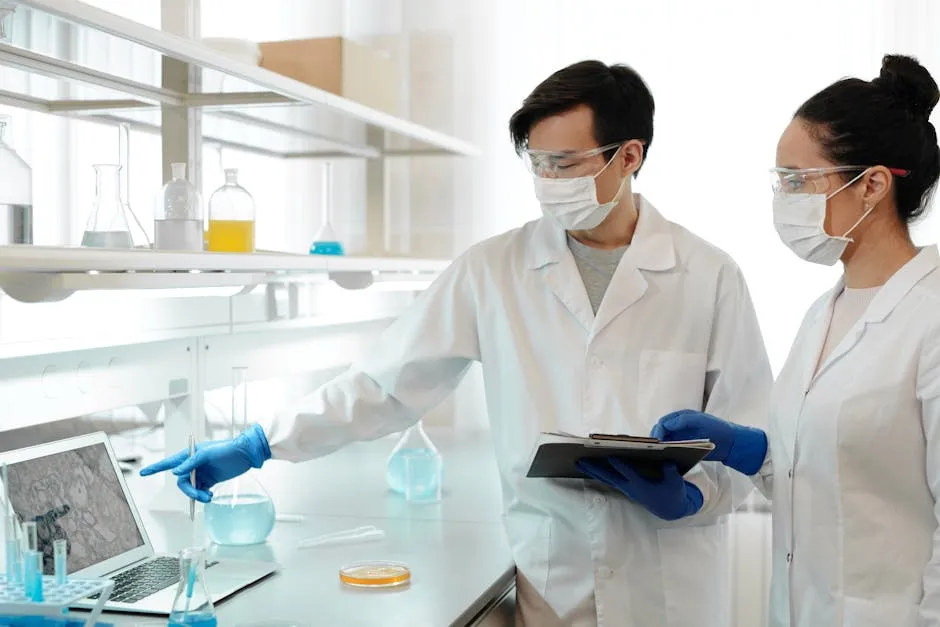Introduction
Biology and statistics are an unlikely duo, yet they dance together like pros. Imagine a world where biological questions are answered through rigorous data analysis. That’s the magic! In biological research, statistical methods help scientists make sense of the chaos. Whether it’s examining cell growth or analyzing genetic variations, stats are the unsung heroes.
Statistical methods provide the tools to extract meaningful insights from biological data. This is crucial for validating hypotheses and ensuring robust conclusions. With the ever-growing complexity of biological systems, the role of statistics has never been more vital.
Now, let’s talk big data. In today’s biological landscape, researchers face a deluge of data from high-throughput technologies. From genomics to proteomics, the volume is staggering. This is where statistical analysis steps in. It helps researchers interpret vast datasets, revealing patterns and trends that would otherwise go unnoticed.
Speaking of understanding data, if you’re looking to dive deeper into the world of statistics, The Art of Statistics: Learning from Data is a fantastic read. It provides insights into how data can tell stories, and trust me, you don’t want to miss out on this enlightening experience!
With the marriage of biology and statistics, researchers can unlock new frontiers. They can make informed decisions that drive innovation. So buckle up! The synergy between biology and statistics is a thrilling adventure, paving the way for discoveries that can change the world.

To dive deeper into the foundational aspects of statistics in research, check out this introduction to statistical learning with Python.
The Role of Statistics in Biological Research
Understanding Biostatistics
Biostatistics is the branch of statistics tailored for biological research. It’s not just numbers; it’s a toolkit for biologists. With its help, researchers design experiments and analyze data effectively. The importance of biostatistics cannot be overstated. It ensures that studies are scientifically valid and that conclusions drawn are reliable.
Historically, key figures like Ronald Fisher and Sewall Wright pioneered the integration of statistics into biology. Fisher introduced techniques like ANOVA and p-values, transforming the landscape of experimental design. These milestones laid the groundwork for modern biostatistics, enabling researchers to quantify uncertainty and variability in their data.
If you’re curious about enhancing your statistical skills, grab a copy of Biostatistics: A Guide to the Analysis of Biological Data. This book is a treasure trove of information that will help you navigate through statistical complexities in biological data analysis.
Types of Biological Data
Biologists gather various types of data, primarily qualitative and quantitative. Qualitative data includes observations made during experiments, while quantitative data involves numerical measurements. Understanding these types is crucial for selecting appropriate statistical methods.
Data collection is the backbone of experimental design. A well-designed experiment ensures that the data collected is relevant and reliable. Researchers must consider various factors, such as sample size and randomization, to minimize bias and improve the validity of their findings.

Statistical Methods Commonly Used in Biology
In the realm of biological research, several statistical tests are frequently employed. T-tests, ANOVA, and regression analysis are among the most common. T-tests compare the means of two groups, helping researchers determine if differences are statistically significant.
ANOVA, on the other hand, allows the comparison of means across multiple groups. Regression analysis helps assess relationships between variables, offering insights into how one variable may influence another.
Understanding p-values and confidence intervals is essential for interpreting statistical data. A p-value indicates the probability of observing results as extreme as those obtained, assuming the null hypothesis is true. Confidence intervals provide a range of values likely to contain the true population parameter, adding another layer of insight.
To further your understanding of statistical methods, consider exploring The Elements of Statistical Learning: Data Mining, Inference, and Prediction. This book provides a comprehensive overview of statistical learning techniques that are essential for anyone diving into data science.
In summary, statistics play a pivotal role in biological research. From understanding biostatistics to applying various statistical methods, the interplay between biology and statistics is essential for advancing our knowledge of life sciences.

The Experimental Design Process
Key Concepts in Experimental Design
When it comes to experimental design, a well-formed hypothesis is your trusty compass. A hypothesis is a testable statement predicting the relationship between variables. It’s essential to also formulate a null hypothesis, which asserts that no relationship exists. This serves as a baseline, allowing scientists to challenge their assumptions.
Selecting an appropriate sample size can feel like ordering a coffee — too small, and you’re left wanting; too large, and you might drown in data. A proper sample size ensures that the results are statistically significant, making your findings more reliable.
Randomization techniques are equally crucial. Imagine flipping a coin to decide who gets the new drug in a clinical trial. Randomization eliminates bias, ensuring that each participant has an equal chance of being assigned to any group. This solid foundation allows scientists to draw valid conclusions from their experiments.
If you’re looking to get more hands-on with statistical programming, don’t miss out on The R Book. This book is a practical guide to using R for statistical analysis, making it a must-have for aspiring data scientists.
Common Pitfalls in Experimental Design
Unfortunately, even the best-laid plans can lead to pitfalls. One common issue is bias. Think of bias as a sneaky gremlin that can skew results. It can creep in through various channels, such as selection bias, where certain groups are favored over others.
Confounding variables are another troublesome aspect. These are lurking variables that can influence the outcome, leading to false conclusions. For instance, if you were studying the effects of a new fertilizer on plant growth but didn’t account for sunlight exposure, you could end up attributing growth to the fertilizer when, in reality, it’s all due to more sun.
Replicability is vital in science. If an experiment cannot be replicated, how can we trust the results? Poor statistical practices, such as cherry-picking data or ignoring outliers, can lead to flawed biological conclusions.
Consider a study that claims a new diet leads to weight loss, but the researchers only report results from participants who lost weight. This selective reporting creates a false impression of effectiveness. Transparency in data reporting is essential to avoid such pitfalls.
The experimental design process is like creating a recipe. You need the right ingredients, a clear procedure, and attention to detail to whip up reliable results. By avoiding common traps and focusing on sound methodologies, researchers can ensure their findings contribute meaningfully to scientific knowledge.

Statistical Analysis Techniques in Biology
Descriptive Statistics
Descriptive statistics are the backbone of data analysis in biology. They summarize large datasets, making complex information digestible. Imagine trying to explain a crowd of people — it’s much easier to discuss the average height than every individual’s height.
Descriptive statistics typically include measures like the mean, median, and mode. The mean is the average of all data points, giving a quick snapshot of the dataset. The median, on the other hand, represents the middle value when data points are arranged in order. This can be particularly useful when dealing with outliers that might skew the mean.
Mode, the most frequently occurring value, can provide insights into common traits or responses within a dataset.
Standard deviation is another critical metric. It measures the spread of data around the mean. A low standard deviation indicates that data points are close to the mean, while a high standard deviation shows they are spread out. This is vital for understanding variability in biological experiments.
In summary, descriptive statistics are essential for summarizing and interpreting biological data. They provide a solid foundation for further analysis, helping researchers draw meaningful conclusions from their experiments.

Inferential Statistics
Inferential statistics is the superhero of the statistical world. It helps scientists make educated guesses about large populations based on sample data. Think of it as looking at a slice of pizza and trying to figure out how cheesy the whole pie is! This branch focuses on hypothesis testing, allowing researchers to test assumptions and draw conclusions.
When conducting hypothesis testing, scientists set up two competing statements: the null hypothesis (no effect) and the alternative hypothesis (some effect). They then analyze the data to see if there’s enough evidence to reject the null hypothesis. This is where p-values come into play, providing a measure of the strength of the evidence against the null.
Different inferential tests cater to various scenarios. For example, t-tests compare means between two groups, while ANOVA assesses differences among three or more groups. Chi-square tests evaluate categorical data, revealing whether distributions differ from what is expected. Each test has its unique applications and assumptions, making it crucial for biologists to select the right one. This ensures that their findings are robust and trustworthy.
For a deeper understanding of hypothesis testing, refer to this comprehensive statistics hypothesis testing cheat sheet.
Advanced Statistical Techniques
In today’s fast-paced biological research landscape, advanced statistical techniques are like the Swiss Army knives of data analysis. They tackle complex datasets with finesse, helping researchers uncover insights that traditional methods might miss. Let’s break down some of these techniques.
Multivariate analysis is one such powerhouse. It examines multiple variables simultaneously, revealing relationships that might be hidden when looking at them in isolation. Imagine trying to understand the relationship between various environmental factors and plant growth. A multivariate approach can help decipher this intricate web.
Bayesian statistics adds another layer of sophistication. It allows researchers to incorporate prior knowledge into their analyses, updating beliefs as new data emerges. This is particularly useful in genetics, where past studies can inform current research.
To dive into some hands-on statistical learning, consider Data Science for Business: What You Need to Know about Data Mining and Data-Analytic Thinking. This book will equip you with the knowledge to leverage data science in business scenarios!
Machine learning is the trendy new kid on the block. It uses algorithms to detect patterns in massive datasets, a common occurrence in genomics and proteomics. Imagine training a computer to recognize cancerous cells by feeding it thousands of images—this is where machine learning shines!
Together, these advanced techniques empower biologists to tackle the complexities of modern datasets. They provide innovative ways to analyze data and draw meaningful conclusions, enhancing our understanding of biological systems and processes.

Challenges and Future Directions
Addressing Limitations of Current Statistical Methods
Biological data analysis is no walk in the park. Researchers often face a slew of challenges that can trip them up. One of the most prevalent issues is data quality. Think of it as trying to bake a cake with expired ingredients—results are bound to be less than appetizing. Poor quality data can lead to biased outcomes and questionable conclusions.
Another common pitfall is overfitting. Overfitting occurs when a statistical model learns the noise in the data instead of the underlying signal. It’s like a student memorizing answers for a test without understanding the material; they might ace the exam but struggle to apply their knowledge later. This can result in models that perform well on training data but flop in real-world applications.
The importance of developing new statistical approaches tailored for biological research cannot be overstated. Traditional statistical methods often don’t adequately address the complexities of biological systems. For instance, high-dimensional data from genomics studies requires specialized techniques. Current methods may fail to capture the intricacies of interactions among numerous variables.
There’s also the pressing need for better statistical education among biologists. Many researchers lack a solid understanding of statistical principles, relying on software without grasping the underlying concepts. This gap in knowledge can lead to misinterpretation of results or misuse of statistical tests.
To tackle these issues, the field must embrace innovative statistical methodologies. Machine learning offers promising avenues. Algorithms can adapt to new data, improving predictions and insights. By integrating machine learning with traditional statistics, researchers can enhance their analytical capabilities.
Collaboration is another key to overcoming these challenges. Biologists should partner with statisticians to design robust studies from the start. A multidisciplinary approach can lead to more accurate models and better interpretation of data.
As we look to the future, it’s clear that addressing these limitations is crucial. By refining statistical methods and enhancing education, the scientific community can unlock new insights in biology. The future of biological research is bright, but it hinges on our ability to adapt and innovate in the face of data challenges.

The Future of Statistics in Biology
As we gaze into the crystal ball of biostatistics, the future looks bright and data-driven. Advancements in technology, especially machine learning and big data analysis, will revolutionize how biologists interpret complex datasets. Imagine algorithms that can predict disease outbreaks or genetic mutations faster than you can say “statistical significance!”
Machine learning will empower biologists to sift through mountains of data with ease. This means identifying patterns in gene expression or predicting how ecosystems will respond to climate change could become routine. The ability to analyze vast amounts of data will lead to faster discoveries and innovations in medicine, agriculture, and environmental science.
However, the magic doesn’t stop at technology. Interdisciplinary collaboration is essential. Biologists and statisticians must join forces like a superhero team. Biologists possess the biological insights, while statisticians bring the analytical prowess. Together, they can design robust experiments and interpret data more effectively.
Imagine a world where researchers collaborate seamlessly, sharing knowledge and techniques. This synergy can lead to more reliable findings and breakthroughs that push the boundaries of science. Biologists must embrace statistical literacy. By brushing up on statistical methods and modeling techniques, they can enhance their research quality.
In summary, the future of statistics in biology is not just about crunching numbers. It’s about harnessing technology and fostering collaboration. As these fields converge, we can expect exciting advancements that will shape the future of biological research. The possibilities are endless, and the journey is just beginning.

FAQs
What is biostatistics?
Biostatistics is a specialized field that applies statistical methods to biological research. It encompasses designing experiments, analyzing data, and interpreting results. For example, it’s used in clinical trials to assess treatment efficacy or in genetics to analyze gene expression patterns.
Why is statistics important in biology?
Statistics enhances the validity and reliability of biological research. By applying statistical methods, researchers can draw accurate conclusions from their data, reducing the risk of errors and biases. This leads to more trustworthy findings that can inform future studies.
What are some common statistical tests used in biology?
Common statistical tests in biology include t-tests, ANOVA (Analysis of Variance), and chi-square tests. Each serves a different purpose: t-tests compare means between groups, ANOVA assesses differences among multiple groups, and chi-square tests analyze categorical data.
How can biologists improve their statistical skills?
Biologists can enhance their statistical skills through various resources. Online courses, workshops, and textbooks provide valuable information. Familiarizing oneself with statistical software like R or SAS can also be beneficial. Engaging in collaborative projects with statisticians can further improve understanding and application of statistical methods.
Please let us know what you think about our content by leaving a comment down below!
Thank you for reading till here 🙂
All images from Pexels




